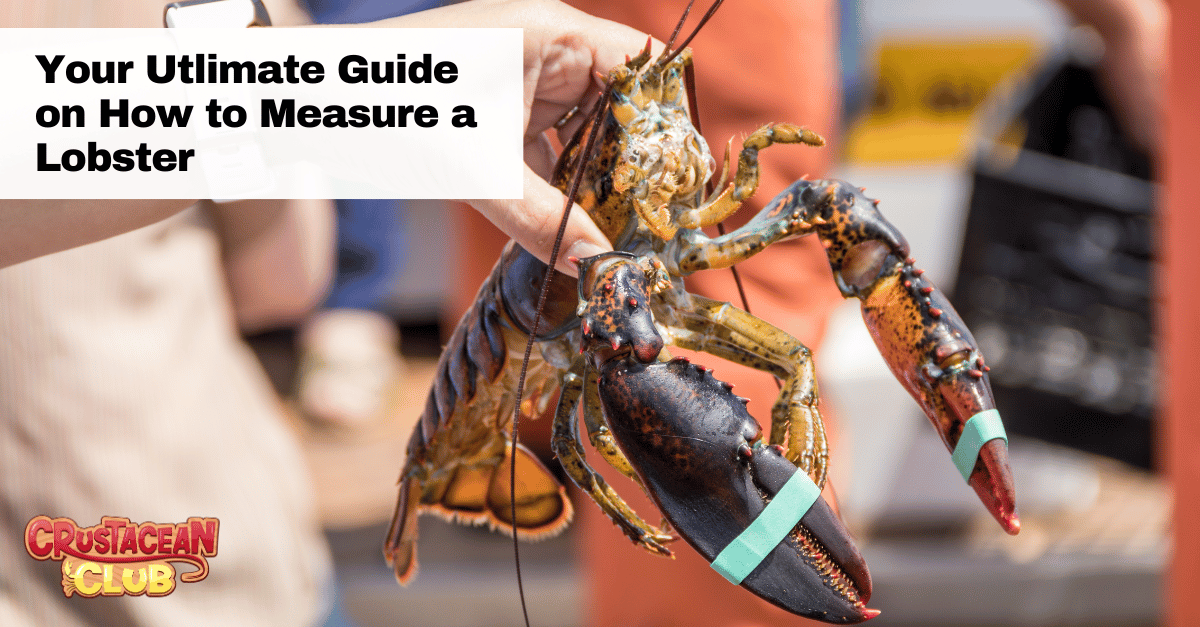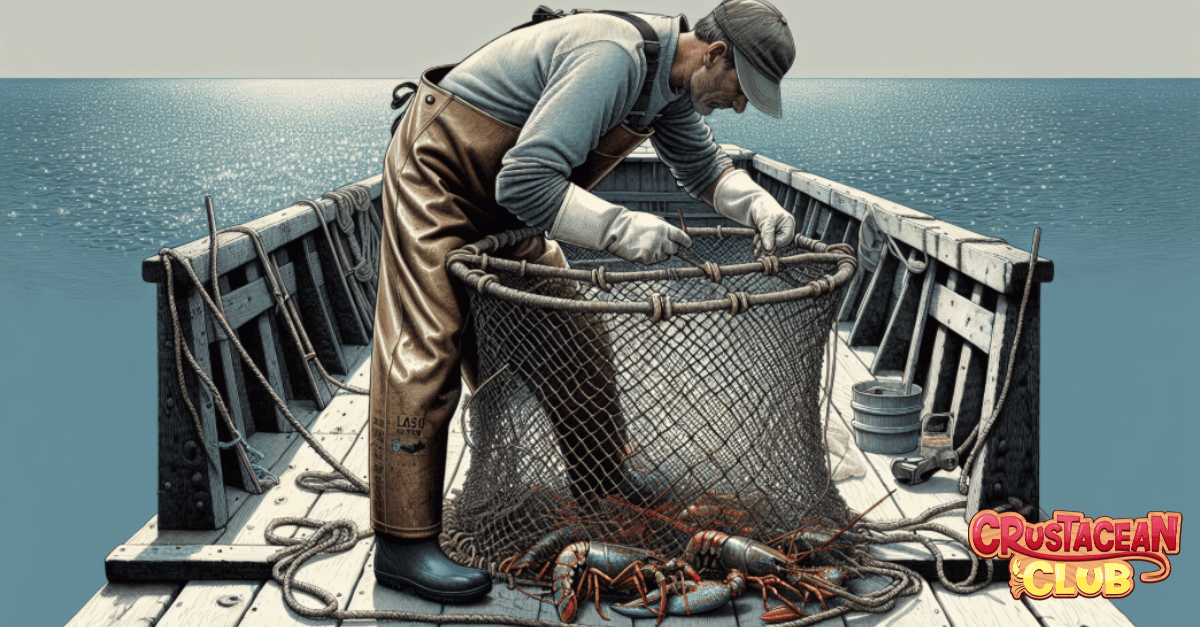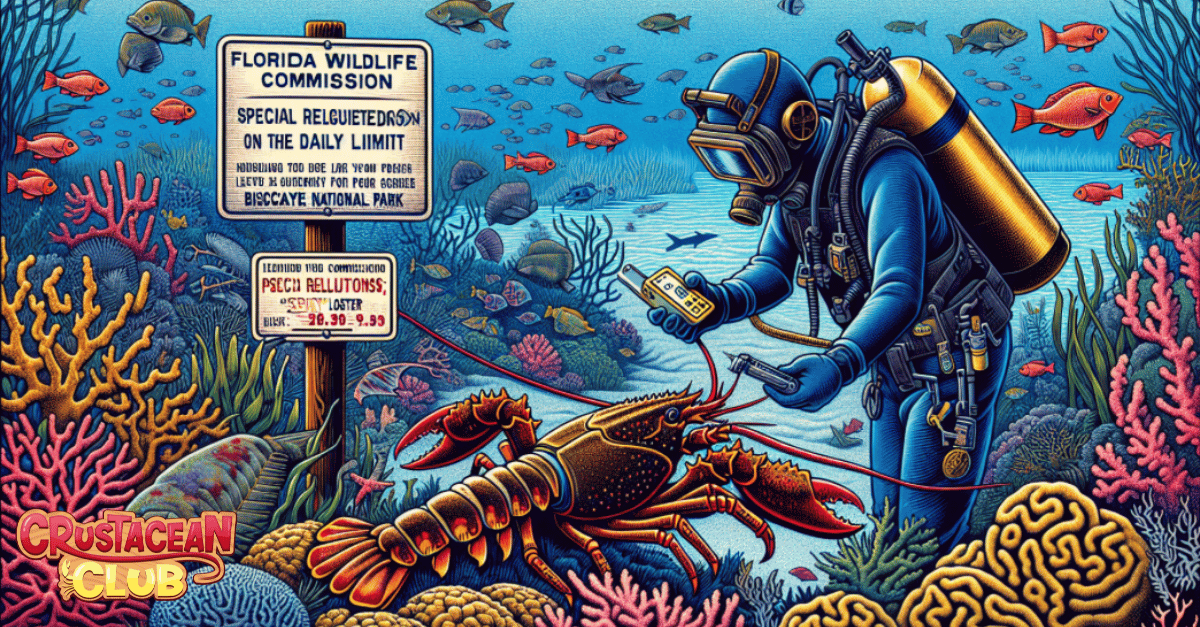Measuring a lobster is crucial for legal fishing and culinary success. This guide provides the straightforward instructions on how to measure a lobster without any fluff. Dive into the essentials of lobster measurement and support sustainable practices with every measure you take.
Check out the Crustacean Club site for additional information on all things lobster!
Key Takeaways
- A lobster gauge is crucial for ensuring lobsters are within the legal size limits, promoting both legal compliance and sustainability of lobster populations.
- Lobsters must be measured immediately after capture, and those not meeting size regulations must be released to support breeding populations and conserve the species.
- Non-compliance with lobster size regulations can lead to substantial fines, emphasizing the importance of ethical practices and conservation efforts in lobster fishing. Learn more about rules and regulation when lobstering in our expert guides.
We love hearing from our readers and subscribers, so please feel free to reach out and contact us today!
Essential Tools for Measuring Lobsters
Imagine you’re on a boat, the salt air filling your lungs, and in your hand, you hold the key to sustainable lobster fishing – a lobster gauge. This unassuming tool is a lobsterman’s best friend, ensuring accurate measurements and adherence to fishing laws, which ultimately contribute to the sustainability of lobster populations.
The lobster gauge assists in verifying whether the lobsters comply with the region-specific legal shell length. For example, in the chilly waters of Maine, the legal shell length is between 3-1/4 inches and 5 inches. The employment of a lobster gauge not only ensures adherence to legal guidelines but also safeguards the lobster breeding population. It’s a win-win situation!
Furthermore, always ensure your safety and the safety of our oceans on your lobster hunting expeditions by reading our Expert Guide to Lobster Season in Florida: Tips and Regulations for a Succulent Catch!
The Lobster Gauge: Your Best Friend in Measurement
Now, let’s get up close and personal with our trusty friend, the lobster gauge. This tool is purpose-built to measure the lobster’s carapace length, which validates that we meet the legal size prerequisites. Measuring the carapace length is important because it tells us whether the lobster is an adult capable of reproduction, or a juvenile that needs more time to grow.
Using the gauge is as easy as pie. One end hooks behind the lobster’s eye socket, serving as the starting point for our measurement. We then slide the gauge back until it stops at the end of the carapace, marking the end point of our measurement. Despite its simplicity, this tool plays a vital part in lobster conservation.
Understanding the Measuring Device
While the lobster gauge appears basic, mastering its appropriate use is fundamental to precise measurements. The gauge has a hook on one end, which you place behind the lobster’s eye socket. The opposite end of the gauge then lines up with where the carapace meets the tail.
But why is it so important to get this measurement right? Well, in Maine, for instance, regulations require both undersized and oversized lobsters to be released back into the sea. This is to preserve breeding populations and contribute to the sustainability of lobster populations. Thus, the correct usage of the lobster gauge goes beyond legal compliance; it’s about honoring the lives and future of our crustacean companions.
Preparing Your Lobster Net
But wait, we’re not done with our tools of the trade just yet! Along with the lobster gauge, we also need a good lobster net. This tool is integral for securing the lobsters once they have been caught in the trap.
Of course, catching and handling lobsters require more than just a net and a gauge. Lobstermen also use:
- traps
- bait bags
- banding tools
- heavy-duty gloves
to ensure lobsters are caught safely and handled properly. Collectively, these tools prepare us for the measurement process. It’s like being a superhero, but instead of fighting crime, we’re ensuring sustainable lobster fishing practices. Learn about common lobstering locations in Florida by visiting the Crustacean Club’s Hot Spot Locations list!
Step-by-Step Guide to Measuring a Lobster
Alright, now that we’ve got our tools and we understand why we’re doing this, let’s get to the real action – measuring a lobster. As soon as you’ve got a lobster in your net, it’s time to pull out your trusted gauge. Remember, lobsters must be measured as soon as they are captured and before they are removed from the water, just like when you measure fish, except when caught with a bully net.
The proper measurement of a lobster’s carapace is taken from the rear of the eye socket to the back of the shell. Immediate measurement of lobsters post-capture is imperative to adhere to marine conservation standards. Just think of it as giving your lobster a quick check-up before it heads to the dinner table… or back to its ocean home.
Identifying the Measurement Points
So, where exactly do we place our lobster gauge? Well, you have to identify the correct points on a lobster’s carapace for accurate measurement. The forward edge of the carapace, especially the area at the rear of the eye socket, is where we start.
Subsequently, we move the gauge along the carapace until it aligns with the rear edge, near the rostral horns. This ensures we’re assessing the full carapace length. The process is somewhat similar to checking if a piece of furniture would fit in your room. Too big or too small, and it just won’t work!
Measuring Carapace Length Accurately
When measuring the carapace length, we need to be accurate. This necessitates a flexible measuring tape and a straight line measurement, contrary to following the lobster’s body contour. This prevents overestimation and ensures we’re getting the right size.
Now, while we do want to be accurate, we also need to be gentle. Remember, these are living creatures we’re handling! So, when using your lobster gauge or measuring tape, make sure you’re not injuring the lobster. Combining accurate measurement with ethical practices is the key to sustainable lobster fishing.
Handling Non-compliant Lobsters
Not all lobsters pass the size test though. In Maine, a lobster must have a carapace length between 3-1/4 inches and 5 inches to be legally harvested. If a lobster doesn’t meet these size regulations, it must be released back into the water promptly.
But what if you’re on a commercial trap vessel? The same rules apply! Any lobsters falling short of the size requirement must be released unharmed and alive upon trap retrieval. It’s a bit like fishing for goldfish at a fair. If you catch a teeny one, you’ve gotta let it go!
Legal Requirements and Regulations
Now that we’re experts in measuring lobsters, let’s delve into the legal side of things. There are specific requirements and regulations for lobster harvesting. For instance, a lobster must have a minimum legal carapace length of 3 1/4 inches to be legally harvested.
But it’s not just about the minimum size. Additionally, there is an upper size limit of 5 inches for legally harvesting a lobster, which safeguards larger, breeding lobsters. And in sunny Florida, the spiny lobsters’ carapace must be larger than 3 inches to be legally harvested. Though these rules may appear stringent, they are indispensable for the maintenance of healthy lobster populations.
Make sure that you know the requirements and regulations for your county as they vary.
Florida Wildlife Commission Guidelines
For those of you in Florida, especially near the Everglades National Park in Monroe County, there are some specific guidelines you need to be aware of. The Florida lobster season, also known as the spiny lobster season, runs from August 6th to March 31st, during which legal harvesting is allowed. Make sure to follow the regulations set by the Florida Wildlife Commision to ensure a sustainable and enjoyable experience.
For those lobstering in Biscayne National Park, special regulations apply to spiny lobster traps and harvest, indicating the heightened protection of marine life in this area. And while there’s no daily bag limit for the trap fishery, there is a limit of 250 lobsters per vessel for bully net and dive fisheries in specified counties. This ensures sustainable harvesting practices are followed.
Special Considerations for Eggbearing Spiny Lobster
Now, there’s one more thing you should know about. A lobster carrying orange-colored eggs under its tail is identified as an eggbearing spiny lobster. And possession of these lobsters is strictly prohibited.
If you catch an eggbearing spiny lobster, it must be immediately released back into the water. It’s like finding a pregnant deer in the woods. You wouldn’t harm it, would you? The same principle applies here.
Consequences of Non-Compliance
Now, you might be wondering, “What if I don’t follow these rules?” Well, the consequences of non-compliance can be hefty. Breaching lobster size regulations can result in substantial fines.
In fact, fines can reach up to $500 for each lobster that is outside the legal size parameters. And the penalties increase with the number of lobsters found to be non-compliant during an infringement. There’s even a $400 fine for each lobster that exceeds the maximum size limit. So, it’s best to stick to the rules and keep the lobsters – and your wallet – happy!
Conservation and Ethical Practices
While all this talk about measuring and regulations might seem a bit tedious, it’s all part of a larger effort towards conservation and ethical practices. In Maine, lobster fishermen have been upholding a tradition of sustainable fishing for over 150 years.
This includes:
- Using impact-reducing gear
- Opposing non-selective harvesting legislation
- Teaching next-generation lobster fishermen sustainable fishing approaches through apprentice programs
It’s a fantastic example of collaboration among fishermen, researchers, and policymakers, preventing the collapse of the fishery industry and ensuring the future of lobsters.
The Role of Measurements in Conservation
So, where do measurements come into play in this scenario? Well, by ensuring that only mature lobsters are harvested, we’re supporting sustainable populations and ecosystems.
There’s also a practice called V-notching, where fishermen mark egg-bearing female lobsters to ensure their release if caught again. This, along with using lobster nets and measuring tools, aids in ensuring the catch meets legal size requirements, which assists the conservation of the lobster population. So, every time you measure a lobster, you’re contributing to its conservation!
Ethical Catch and Release
Catch and release isn’t just about following the rules. It’s also about being ethical. We need to handle lobsters humanely to minimize stress and injury during the catch and release process.
This involves maintaining the lobsters in a cold environment prior to release to minimize their stress levels and decelerate metabolism. And when releasing them, always place them into the water head first to reduce potential injury and stress. Remember, being a responsible lobster hunter means respecting the lobsters and their environment.
Cooking Considerations Post-Measurement
Alright, we’ve done our part for conservation and followed all the rules. Now we get to the fun part – cooking! But did you know that the size of your lobster can influence how you cook it? Despite the common misconception that larger lobsters yield tougher meat, they are actually preferred for their rich, tender flesh.
Grade A lobsters, characterized by hard shells and a higher meat density, offer a superior quality of meat over soft shell lobsters, which have about 10% less meat yield. So, the next time you’re at the fish market, you’ll know exactly what to look for!
Matching Size with Cooking Methods
Now, once we’ve chosen our perfect lobster based on its size and quality, it’s time to decide on the cooking method. Larger lobsters provide a greater quantity of meat, making them suitable for cooking methods ideal for multiple servings.
The size of the lobster significantly influences the selection of an appropriate cooking technique. Different cooking methods like steaming, boiling, and grilling are better suited to lobsters of varying sizes. So, before you fire up the grill or fill the pot with water, consider the size of your catch!
Be sure to access our library of recipes to learn new ways to create a sumptuous lobster meal!
Transporting Your Catch
Finally, upon capturing and measuring your lobster, it must be transported safely. To keep the lobster fresh, maintain an environment similar to its natural habitat during transportation.
If you’re transporting small quantities of live lobsters, use a cooler with wet newspaper or seaweed on top to keep them moist. And always be aware of local regulations that may dictate specific containment methods or restrictions on transporting lobsters through particular areas or across state lines. Because the last thing you want is to go through all this effort, only to have your prize catch confiscated!
Summary
We’ve journeyed through the fascinating world of lobster measuring – from the essential tools and step-by-step guide to legal requirements and ethical practices. Measuring a lobster isn’t just about following the rules or getting the best catch for your dinner. It’s an act of conservation, ensuring sustainable lobster populations for future generations.
So, the next time you’re out on the water, lobster gauge in hand, remember that you’re not just a fisherman. You’re a guardian of the sea, playing a crucial role in the conservation of our precious lobster populations. Now, isn’t that a catch worth celebrating?
Learn more about us and the wealth of knowledge we have to offer here at Crustacean Club about all things, well, crustacean!
Frequently Asked Questions
Why do I need to measure a lobster?
Measuring a lobster is important to ensure it meets legal size requirements for harvesting and contributes to sustainable lobster populations. This helps maintain a healthy and balanced ecosystem.
How do I use a lobster gauge?
To use a lobster gauge, hook one end behind the lobster’s eye socket and slide it back until it stops at the end of the carapace. That’s it!
What happens if I catch an undersized or oversized lobster?
If you catch an undersized or oversized lobster, make sure to release it back into the water promptly to comply with size regulations.
Can I keep an eggbearing spiny lobster?
No, you cannot keep an eggbearing spiny lobster. It’s prohibited, and they should be immediately released back into the water.
How do I choose the best cooking method for my lobster?
Choose the cooking method based on the size of the lobster – larger lobsters are best for methods suited for multiple servings.
Hi! My name is Jessica, and I am the Head of Content for Crustacean Club. If you woul like any changes or if you want to submit a blog, DM me!

























